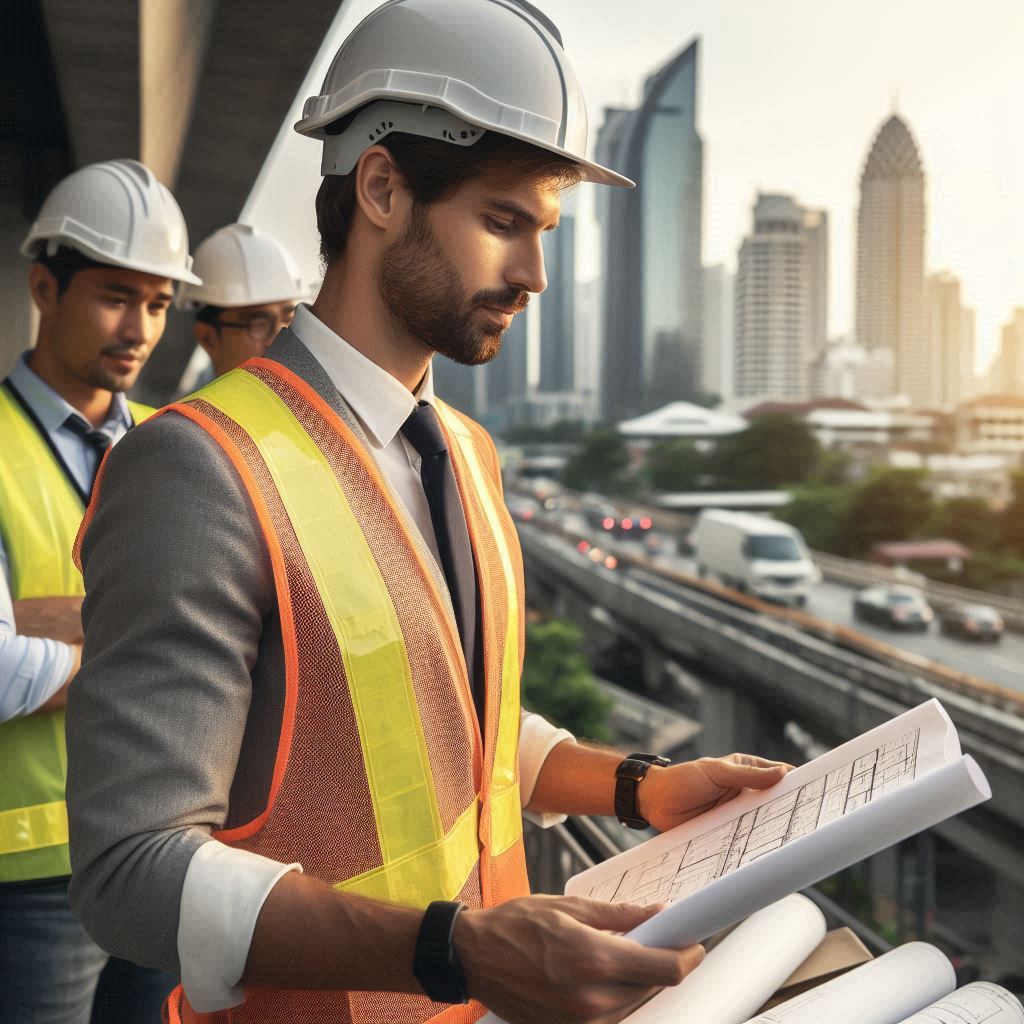Introduction
Transportation engineering is a vital field focused on designing and improving transportation systems.
It combines principles from civil engineering, planning, and logistics.
Transportation engineers work to create efficient and safe infrastructure, including roads, bridges, and transit systems.
These professionals address various challenges such as traffic congestion, safety hazards, and environmental impact.
They analyze traffic patterns, develop solutions for smoother traffic flow, and ensure that infrastructure meets safety standards.
Their work directly influences how people and goods move within and between communities.
Ensuring the efficiency of transportation systems is crucial for economic growth.
Well-designed systems reduce travel time, lower transportation costs, and improve overall quality of life.
Transportation engineers use advanced technology and data analysis to optimize these systems.
Safety is another critical focus.
Engineers implement measures to minimize accidents and enhance road safety.
They design features like traffic signals, road markings, and pedestrian crossings to protect all road users.
Generally, transportation engineers play a pivotal role in shaping how we travel.
Their expertise ensures that transportation networks are not only functional but also safe and sustainable.
Their work supports the seamless movement of people and goods, driving progress and enhancing daily life.
Education and Training
Required Educational Background
To effectively navigate these regulations, engineers typically start with a strong educational foundation.
A Bachelor’s degree in civil engineering or a related field is essential.
This academic background provides engineers with the fundamental knowledge needed to understand and apply complex regulations.
Coursework includes subjects like structural analysis, transportation planning, and environmental engineering, all of which are crucial for ensuring compliance with safety standards.
Additional Certifications or Licenses
Beyond their degree, many engineers pursue additional certifications or licenses to enhance their qualifications.
A Professional Engineer (PE) license is particularly important.
This certification demonstrates a high level of expertise and commitment to the field.
Obtaining a PE license often requires passing rigorous exams and accumulating a certain amount of work experience.
The license not only validates an engineer‘s knowledge but also their ability to apply it in real-world scenarios, including adhering to safety regulations.
Importance of Ongoing Professional Development and Staying Updated on Industry Trends
Regulations and technologies in transportation engineering are constantly evolving.
To keep up, engineers must engage in ongoing professional development.
This continuous learning process involves attending workshops, seminars, and industry conferences.
Staying updated on industry trends allows engineers to implement the latest safety measures and technologies effectively.
For instance, new materials or techniques might offer better safety features or more efficient designs.
Engineers also benefit from joining professional organizations and networks.
These platforms provide valuable resources, such as industry news and best practices.
They also offer opportunities for peer collaboration and knowledge exchange.
Engaging with these communities helps engineers stay informed about regulatory changes and emerging trends.
Read: The Role of Aerospace Engineers in Satellite Development
Designing Transportation Systems
Creating Roadways, Bridges, and Other Infrastructure to Support the Flow of Traffic
Transportation engineers are instrumental in designing roadways, bridges, and other critical infrastructure to support traffic flow.
Their work ensures that these structures facilitate efficient movement while adhering to safety regulations.
Engineers must consider various factors in their designs to optimize traffic management and system performance.
To begin with, engineers focus on creating roadways that can handle current and future traffic demands.
They design roads with appropriate lane widths, curvature, and signage to manage traffic flow effectively.
Bridges must be designed to withstand heavy loads and environmental stresses while providing safe passage.
Engineers also plan for intersections and interchanges to prevent congestion and accidents.
Consideration of Factors Like Traffic Volume, Safety Regulations, and Environmental Impact
Engineers take into account multiple factors when designing transportation systems.
Traffic volume is a primary consideration; engineers analyze traffic patterns to ensure that roadways and bridges can accommodate peak loads.
They use traffic studies and simulation models to predict future needs and adjust designs accordingly.
Safety regulations are paramount in every project.
Engineers must adhere to local, state, and federal guidelines, which cover aspects like road design, signage, and safety barriers.
Ensuring compliance with these regulations helps prevent accidents and improves overall road safety.
Environmental impact is another critical factor.
Engineers assess how their designs affect the environment, including potential disruptions to wildlife and natural habitats.
They incorporate eco-friendly practices such as stormwater management systems and sustainable materials to minimize negative impacts.
Balancing infrastructure needs with environmental stewardship is a key aspect of their role.
Use of Advanced Software and Technology for Design and Analysis
The use of advanced software and technology revolutionizes how transportation engineers approach their projects.
Modern design tools allow engineers to create detailed and accurate models of roadways, bridges, and other infrastructure.
These tools enable simulations and analyses to predict how designs will perform under various conditions.
Software applications help engineers visualize traffic patterns and test different scenarios to optimize their designs.
For instance, traffic simulation software can model the effects of new road layouts or changes in traffic flow.
This helps engineers identify potential issues and make data-driven decisions.
Read: Aerospace Engineering in Commercial Spaceflight
Traffic Management and Planning
Analyzing Traffic Patterns and Behavior to Optimize Road Networks
To ensure compliance, engineers start by analyzing traffic patterns and behavior.
They study how vehicles and pedestrians interact with the road network.
This analysis helps identify congestion points, accident hotspots, and areas needing improvement.
By understanding these patterns, engineers can design road networks that better manage traffic flow and enhance safety.
They use data from traffic studies, sensors, and surveillance cameras to make informed decisions.
Their goal is to create a road network that minimizes delays and maximizes safety, adhering to all relevant regulations.
Implementing Traffic Control Devices and Systems
Another critical responsibility is implementing traffic control devices and systems.
Engineers install and maintain traffic signals, signs, and other control mechanisms.
These devices must meet local, state, and federal standards to ensure effectiveness and safety.
Engineers select appropriate devices based on traffic volume, road layout, and safety requirements.
They regularly test and calibrate these systems to ensure they function correctly and comply with regulations.
Proper installation and maintenance of traffic control devices are crucial for managing traffic flow and preventing accidents.
Collaborating with Urban Planners and Policymakers
Engineers also collaborate with urban planners and policymakers to improve transportation efficiency.
They work together to integrate transportation systems with broader urban development plans.
This collaboration ensures that transportation solutions align with city growth and development goals.
Engineers provide technical expertise and feedback on proposed plans, ensuring that they meet safety regulations and practical needs.
They help design transportation systems that accommodate future growth and changing patterns.
By working closely with planners and policymakers, engineers contribute to creating efficient, sustainable transportation networks.
Read: Essential Aerospace Engineering Textbooks

Public Safety and Regulations
Ensuring transportation systems meet local, state, and federal safety regulations
Ensuring transportation systems meet local, state, and federal safety regulations is a vital responsibility for transportation engineers.
Engineers play a crucial role in shaping safe and efficient transportation networks.
They are tasked with navigating a complex web of regulations that vary from local to federal levels.
These regulations are essential for maintaining public safety and ensuring that transportation systems function smoothly.
Transportation engineers begin their work by addressing local safety regulations.
Local authorities set specific guidelines and standards for transportation systems within their jurisdictions.
These guidelines cover aspects such as road design, signage, and traffic control measures.
Engineers must ensure that their projects adhere to these local requirements.
This often involves working closely with city planners and other municipal officials to align designs with local needs and conditions.
Meeting Safety Regulations
One of the primary roles of transportation engineers is to ensure that transportation systems comply with safety regulations set by relevant authorities.
These regulations are in place to protect the public and prevent accidents and injuries.
By understanding and implementing these regulations, transportation engineers contribute to creating safer and more secure transportation networks.
Conducting Safety Audits and Assessments
Transportation engineers are responsible for conducting safety audits and assessments to identify potential hazards in transportation systems.
Through these audits, engineers evaluate the safety measures in place, assess risks, and recommend improvements to enhance the overall safety of the systems.
By proactively addressing safety concerns, transportation engineers play a crucial role in mitigating risks and preventing accidents.
Collaboration with Law Enforcement and Emergency Responders
In cases of accidents or emergencies, transportation engineers collaborate closely with law enforcement agencies and emergency responders to manage and mitigate the impacts of such incidents.
This collaboration involves sharing information, coordinating response efforts, and implementing emergency protocols to ensure the safety and well-being of the public.
By working together with these stakeholders, transportation engineers contribute to effective crisis management and response.
Read: The Impact of Aerospace Engineering on Modern Life
Environmental Considerations
Minimizing the environmental impact of transportation projects
- Transportation engineers play a crucial role in ensuring that the environmental impact of transportation projects is minimized.
- They consider factors such as air quality, water pollution, and habitat destruction in their designs and plans.
- By implementing sustainable practices, such as the integration of bike lanes and public transit, transportation engineers help reduce greenhouse gas emissions.
- They prioritize the use of eco-friendly materials and technologies to mitigate the environmental effects of transportation systems.
- From the initial planning stages to the construction phase, transportation engineers work to protect and preserve the natural environment.
Implementing sustainable transportation practices (bike lanes, public transit, etc.)
- One of the key responsibilities of transportation engineers is to promote sustainable transportation practices.
- They advocate for the development of bike lanes, pedestrian-friendly infrastructure, and efficient public transit systems.
- By encouraging alternative modes of transportation, such as walking and cycling, engineers help reduce traffic congestion and air pollution.
- They collaborate with urban planners and policymakers to create integrated transportation networks that prioritize sustainability.
- Through innovative design solutions, transportation engineers contribute to the creation of greener and more livable cities.
Addressing pollution, noise, and other environmental concerns in transportation design and planning
- Transportation engineers consider a range of environmental factors in their design and planning processes.
- They assess the potential impacts of transportation projects on air quality, water resources, and natural habitats.
- Engineers work to minimize noise pollution by implementing sound barriers and designing noise-reducing road surfaces.
- They collaborate with environmental scientists and regulators to ensure compliance with regulations and best practices.
- Through their expertise, transportation engineers help create transportation systems that are environmentally sustainable and socially responsible.
See Related Content: Environmental Engineering Project Management Tips
Cost Estimation and Budget Management
Developing project budgets and cost estimates
Transportation engineers play a crucial role in developing project budgets and cost estimates for transportation infrastructure projects.
They are responsible for accurately estimating the costs involved in completing a project, including materials, labor, equipment, and other expenses.
By examining the scope of the project and considering various factors, transportation engineers can create comprehensive budgets that guide the financial planning and execution of the project.
Transform Your Career Today
Unlock a personalized career strategy that drives real results. Get tailored advice and a roadmap designed just for you.
Start NowMonitoring project expenses
Once a project is underway, transportation engineers must closely monitor project expenses to ensure that they align with the established budget.
This involves tracking costs associated with labor, materials, equipment, and other resources throughout the project lifecycle.
By maintaining detailed records and analyzing spending patterns, engineers can identify any potential cost overruns or inefficiencies and take corrective action to keep the project on track financially.
Ensuring projects are completed within budget
One of the primary responsibilities of transportation engineers is to ensure that projects are completed within budget constraints.
This requires careful planning, monitoring, and adjustment of spending to avoid exceeding the allocated funds.
By implementing cost-saving strategies, negotiating favorable contracts, and making informed decisions, engineers can help keep projects within budget while still meeting all project requirements and quality standards.
Balancing cost considerations with project goals
Transportation engineers must strike a balance between cost considerations and project goals and objectives.
While it is essential to manage costs efficiently, engineers also need to ensure that the project’s overall objectives are met and that quality standards are maintained.
By evaluating trade-offs, exploring alternative solutions, and making informed decisions, engineers can achieve cost-effective outcomes without compromising project success.
Moreover, cost estimation and budget management are critical aspects of the roles and responsibilities of transportation engineers.
By developing accurate budgets, monitoring expenses, ensuring projects stay within budget, and balancing cost considerations with project goals, engineers play a vital role in the successful and efficient delivery of transportation infrastructure projects.
You Might Also Like: Software and Tools for Petroleum Engineers
Collaboration and Communication
Working with a team of engineers, urban planners, government officials, and other stakeholders:
Transportation engineers work closely with a diverse group of professionals to design and implement transportation systems.
Collaboration with engineers ensures that projects are well-rounded and consider multiple perspectives.
Working with urban planners helps in integrating transportation systems with existing infrastructure, creating efficient and sustainable solutions.
Engaging with government officials ensures that projects meet regulatory requirements and align with public policy goals.
Collaborating with other stakeholders such as community members and environmental groups helps in addressing concerns and incorporating community feedback into project designs.
Communicating technical information to non-technical audiences (policymakers, community members)
One of the key responsibilities of transportation engineers is to translate complex technical information into layman’s terms for policymakers and community members.
This involves breaking down technical concepts and data into easily understandable language, ensuring that stakeholders are well-informed and engaged in the decision-making process.
Effective communication helps in gaining support for transportation projects and building trust with the community.
Resolving conflicts and addressing concerns from various stakeholders
Transportation engineers often encounter conflicts and concerns from different stakeholders, including residents, businesses, and advocacy groups.
It is essential for engineers to listen to all viewpoints, understand the underlying issues, and work towards finding mutually agreeable solutions.
By facilitating open communication and collaboration, engineers can build consensus, address concerns, and ensure that transportation projects benefit the community as a whole.
Learn More: Cybersecurity Analyst Bootcamps: Are They Worth It?
Conclusion
Transportation engineers hold pivotal roles in designing and maintaining transportation systems.
They ensure infrastructure meets safety and efficiency standards.
Their responsibilities span from planning and designing roadways to overseeing construction and implementing traffic management systems.
Transportation engineers use advanced technology to improve traffic flow and reduce congestion.
They work closely with urban planners to integrate transportation solutions into city landscapes.
This coordination helps create efficient, sustainable, and accessible transportation networks.
These professionals also evaluate and upgrade existing systems to meet growing demands and environmental standards.
They conduct studies to assess traffic patterns and identify potential hazards.
Their work directly impacts daily commutes, emergency response times, and overall road safety.
The contributions of transportation engineers are vital for economic development and quality of life.
They enhance mobility, reduce travel times, and minimize environmental impacts.
Their efforts lead to safer roads and more reliable public transportation options.
Transportation engineers play a key role in shaping our future transportation systems.
Their expertise ensures that infrastructure supports economic growth and societal needs.
By continually innovating and improving transportation networks, they contribute significantly to the well-being of communities and the efficiency of urban environments.




